Blaise Pascal
June 19, 2012
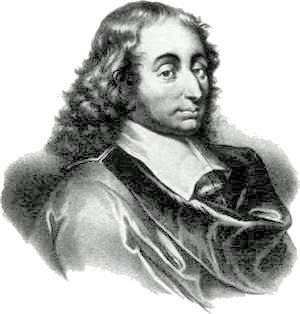 One important feature of science is that discoveries made centuries ago are still useful.
One important feature of science is that discoveries made centuries ago are still useful.
Today, June 19, is the anniversary of the birth of the French mathematician, physicist, inventor and philosopher, Blaise Pascal (June 19, 1623 - August 19, 1662).
Although Pascal lived nearly four hundred years ago, his name is celebrated in many ways.
![]()
• Pascal's triangle, a triangular array of the binomial
coefficients.
• Pascal's pyramid, the trinomial version of his triangle.
• Pascal's theorem, a theorem about hexagons inscribed in conic
sections that he created when he was just sixteen.
• The pascal, a unit of pressure.
• The Pascal computer language.
• Pascal's law of hydrostatics (ΔP = ρgΔh)
• Pascal, a lunar crater at the northwest limb of the Moon.
• Pascal's wager
As I wrote in a previous article (Extreme Intelligence, October 14, 2011) Pascal was a
child prodigy who had an estimated
intelligence quotient (IQ) of 195. As I wrote in that same article,
Albert Einstein and
Stephen Hawking are tied with estimated IQs of 160; while
Richard Feynman had a measured IQ of "only" 126.
Mathematics
Pascal's triangle, introduced in his 1654
Traité du triangle arithmétique (Treatise on the Arithmetical Triangle) is known to most
high school mathematics students. It's easy to construct, and it's a simple way to remember the
coefficients of a
binomial expansion; viz.,
(x + y)4 = x4 + 4x3y + 6x2y2 + 4xy3 + y4
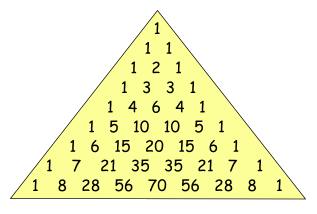
Nine rows of Pascal's triangle.
The fifth row gives the coefficients of the fourth power expansion, above.
(Rendered by the author using Inkscape)
Pascal is best known in mathematics for his work on
probability theory. Pascal and
Pierre de Fermat started the study of
probabilities in an exchange of letters in 1654.[1] They were inspired by the question of how many times a pair of
dice must be cast before a double six will show. The answer, of course, is (6 x 6) = 36.
Some other of Pascal's triumphs involved the
cycloid, the
curve formed by a
point at the
perimeter of a rolling
wheel (see figure). In 1634,
Gilles de Roberval found that the
area under a whole segment of the cycloid is 3πr
2.
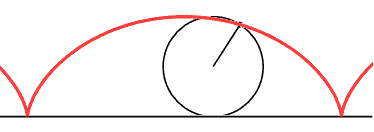
(Modified Wikimedia Commons image))
Pascal extended this result by finding the area under any partial segment of the cycloid, and the
volume and surface area of the
solid of revolution formed by the
rotation of the cycloid about the
x-axis. These were major feats, since
calculus was not available at his time.
Hydrostatics
There's good reason that the unit of
pressure, the
pascal, which is a
newton's force acting over a
square meter, is named after him. Pascal conducted some critical experiments in
hydrostatics, including his famous
barrel experiment, in which he demonstrated the pressure exerted by a long, thin column of water. Pascal was able to burst a wooden
barrel through pressure exerted by water in a ten meter
pipe attached to it.
This experiment confirmed his principle that pressure exerted anywhere in a confined
incompressible fluid is transmitted equally throughout the fluid. His observations are summarized in his
law of hydrostatics,
ΔP = ρgΔh
where ΔP is the pressure change in an incompressible fluid that results from a change in its height Δh. The constant ρ is the fluid
density, and g is the
gravitational acceleration.
Inventions
In a
previous article (Who Invented the Computer?, March 21, 2011), I wrote about a prized possession of mine when I was a child. This was a plastic
pencil box with a
mechanical calculator built into its sliding door. A pencil point could be used to rotate a row of
gear-like wheels to add and subtract very large numbers.
Pascal invented this
mechanical calculator, called a
Pascaline, in 1642 (see photograph). Pascal invented this to help his father, who was a
tax collector, do calculations. The mechanism was much more complicated than the
decimal calculator in my pencil box, since French
currency at the time had 20 sols in a livre and 12 deniers in a sol. In the decade since its invention, fifty of these machines had been built, but few were sold.[2]
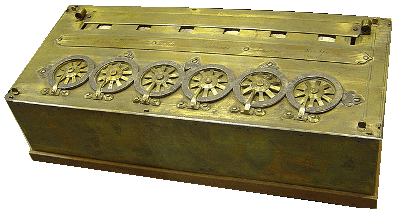
Blaise Pascal's Pascaline (1652). This unit, signed by Pascal, is in the Musée des arts et métiers, Paris.
(Photo by David Monniaux, via Wikimedia Commons)
Pascal, who was interested in the gaming arts from his work on probability, designed a
roulette machine. It's written that this was an outgrowth of an attempt to build a
perpetual motion machine.[3]
Other Things Pascal
Many years ago I programmed extensively in
Pascal, a
language designed by famed
computer scientist,
Niklaus Wirth. This language was named in honor of Pascal, and Wirth cautioned everyone not to write it as PASCAL. I used this language on a
VAX-11/780, and then migrated to
personal computer versions when they became fast enough. Today, I write mostly in
C.
There's a fairly large
lunar crater (115
km diameter), named Pascal (see photograph).
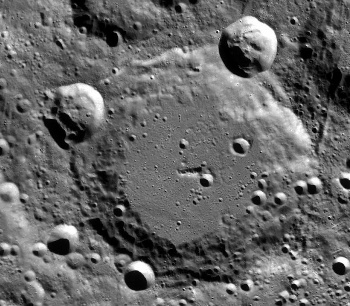
Image of Pascal crater (Coordinates: 74.6°N 70.3°W), taken on December 12, 2011, by the Lunar Reconnaissance Orbiter.
North is towards the upper right corner.
(NASA/LRO-LROC team image))
Pascal is known to non-scientists for his
wager. Pascal reasoned through probability theory that it's only logical to believe in
God. A person will lose nothing by believing in God, if God doesn't exist; whereas a person will lose everything by not believing, if God does exist.[4]
There are many memorable
quotations of Blaise Pascal, but I've found the following two to be the most interesting:
"I would have written a shorter letter, but I did not have the time."[5] (Lettres provinciales, Letter XVI, 1656)[6]
"...it is rare that mathematicians are intuitive, and that men of intuition are mathematicians." (Pensées, 1669)[7]
References:
- D.R. Wilkins, Transcriber, "Blaise Pascal (1623 - 1662)," from "A Short Account of the History of Mathematics," (4th edition, 1908) by W. W. Rouse Ball.
- J. J. O'Connor and E. F. Robertson, "Blaise Pascal." School of Mathematics and Statistics, University of St. Andrews.
- Inventor of the Week, Lemelson-MIT Web Site, May 2003.
- July 1654: Pascal's Letters to Fermat on the "Problem of Points," This Month in Physics History, American Physical Society Web Site.
- "Je n'ai fait celle-ci plus longue que parce que je n'ai pas eu le loisir de la faire plus courte."
- Blaise Pascal, "To The Reverend Fathers, The Jesuits," Letter XVI of The Provincial Letters, December 4, 1656, at the University of Adelaide eBooks web site.
- Blaise Pascal quotations on Wikiquote.
Permanent Link to this article
Linked Keywords: Blaise Pascal; scienc; French; mathematician; physicist; inventor; philosopher; Pascal's triangle; triangular; array; binomial; coefficient; Pascal's pyramid; trinomial; Pascal's theorem; hexagons; conic section; pascal; pressure; Pascal computer language; Pascal's law of hydrostatics; Pascal crater; Pascal's wager; child prodigy; intelligence quotient; IQ; Albert Einstein; Stephen Hawking; Richard Feynman; Traité du triangle arithmétique; high school; mathematics; coefficient; binomial expansion; Inkscape; probability theory; Pierre de Fermat; probability; dice; cycloid; curve; point; perimeter; wheel; Gilles de Roberval; area; Wikimedia Commons; volume; solid of revolution; rotation; x-axis; calculus; newton; square meter; hydrostatics; barrel experiment; barrel; pipe; incompressible; fluid; law of hydrostatics; density; gravitational acceleration; pencil box; mechanical calculator; gear; Pascaline; tax collector; decimal; currency; Musée des arts et métiers; Paris; David Monniaux; roulette; perpetual motion machine; Pascal programming language; programming language; computer scientist; Niklaus Wirth; VAX-11/780; personal computer; C programming language; lunar crater; kilometer; km; Lunar Reconnaissance Orbiter; NASA; LRO-LROC team; Pascal's Wager; God; quotation; Lettres provinciales; Pensées; University of Adelaide; eBooks.